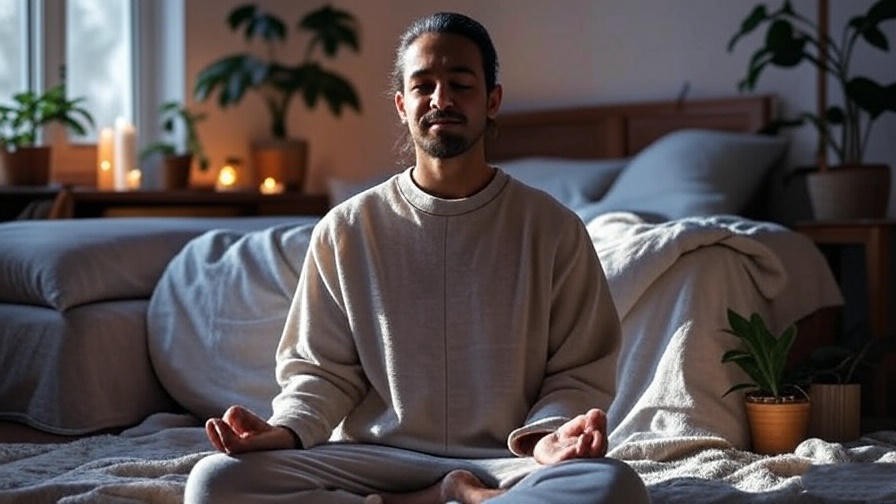Picture this: you wake up feeling groggy, drag yourself through a stressful day, and collapse into bed, wondering why joy feels so elusive. Sound familiar? In a world buzzing with demands, achieving happy everything—a state of daily joy, balance, and well-being—can seem out of reach. Yet, happiness isn’t a distant goal; it’s a skill you can cultivate through intentional habits. This article unveils seven science-backed methods to boost your mood and enhance holistic well-being, drawing from sleep science, mindfulness, and positive psychology. Backed by research from institutions like Harvard Medical School and insights from experts like Dr. Matthew Walker, these strategies are practical, accessible, and transformative. Ready to feel happier every day? Let’s dive in.
Why Happiness Matters for Holistic Well-Being
The Science of Happiness
Happiness isn’t just a fleeting emotion—it’s a cornerstone of health. Research from the Journal of Positive Psychology shows that positive emotions like joy trigger the release of serotonin and dopamine, neurotransmitters that stabilize mood and enhance mental clarity. Happiness also strengthens your immune system, lowers blood pressure, and improves sleep quality, according to studies from the National Institutes of Health (NIH). When you prioritize joy, you’re not just feeling good—you’re building resilience against stress and fostering long-term well-being.
The “Happy Everything” Philosophy
The happy everything approach integrates joy into every aspect of life—sleep, mindfulness, relationships, and more. Unlike quick fixes, this philosophy creates a compounding effect: small, consistent habits amplify your emotional and physical health. Whether you’re meditating for five minutes or savoring a restful night’s sleep, these practices are accessible to everyone, regardless of lifestyle or schedule. By weaving happiness into daily routines, you create a sustainable path to holistic well-being.
Method 1: Prioritize Quality Sleep for a Happier Mind

How Sleep Impacts Mood
Sleep is the foundation of a happy mind. The NIH reports that poor sleep increases cortisol levels, heightening stress and irritability, while adequate rest enhances emotional regulation. During REM sleep, your brain processes emotions through dreams, helping you wake up refreshed and resilient. Dr. Matthew Walker, author of Why We Sleep, notes, “Sleep is the single most effective thing we can do to reset our brain and body health each day.” Without quality sleep, even the best mood-boosting strategies fall short.
Practical Sleep Tips
To harness sleep’s mood-lifting power, try these evidence-based tips:
- Maintain a consistent sleep schedule: Go to bed and wake up at the same time daily, even on weekends, to stabilize your circadian rhythm.
- Create a relaxing bedtime routine: Avoid screens an hour before bed, as blue light suppresses melatonin. Instead, read a book or practice gentle stretching.
- Optimize your sleep environment: Keep your bedroom dark, cool (around 65°F), and quiet. Consider blackout curtains or a white noise machine.
Pro Tip: Invest in a comfortable mattress and pillows to enhance sleep quality—your mood will thank you.
Method 2: Practice Mindfulness and Meditation
The Benefits of Mindfulness
Mindfulness—focusing on the present moment—can transform your emotional landscape. A 2020 study in Mindfulness Journal found that regular meditation reduces anxiety by 38% and boosts positive emotions. By calming the amygdala (the brain’s stress center), mindfulness fosters clarity and joy. It also improves sleep and emotional resilience, making it a cornerstone of the happy everything philosophy.
Simple Meditation Practices
You don’t need to be a Zen master to meditate. Try these beginner-friendly practices:
- 5-minute breathing exercise: Sit comfortably, close your eyes, and focus on your breath. Inhale for four seconds, hold for four, and exhale for six. Repeat.
- Guided meditation apps: Use tools like Headspace or Calm for structured sessions tailored to mood enhancement.
- Body scan technique: Lie down and mentally scan your body from head to toe, releasing tension in each area.
Step-by-Step Guide: For a quick mindfulness boost, set a timer for five minutes. Sit in a quiet space, focus on your breath, and gently redirect your mind if it wanders. This simple practice can shift your mood in moments.
Method 3: Cultivate Gratitude Daily

Why Gratitude Works
Gratitude rewires your brain for happiness. Research from the Greater Good Science Center at UC Berkeley shows that gratitude increases life satisfaction by 25% and reduces depressive symptoms. By focusing on what you’re thankful for, you shift your perspective from scarcity to abundance, fostering joy even on tough days. Gratitude also enhances sleep quality and strengthens relationships, amplifying its impact.
Gratitude Practices
Incorporate gratitude into your routine with these practices:
- Keep a gratitude journal: Each night, write down three things you’re thankful for, no matter how small (e.g., a warm meal, a kind word).
- Write gratitude letters: Pen a heartfelt note to someone you appreciate, even if you don’t send it.
- Practice gratitude in the moment: During daily activities like eating or commuting, pause to appreciate something positive.
Real-Life Example: Sarah, a busy mom, started journaling three things she was grateful for daily. Within two weeks, she reported feeling less overwhelmed and more connected to her family, proving gratitude’s power to transform daily life.
Method 4: Move Your Body to Boost Your Mood
Exercise and Happiness
Physical activity is a natural mood enhancer. The American Psychological Association (APA) reports that exercise increases endorphins, reducing symptoms of depression by up to 30%. Movement also improves sleep and reduces stress, creating a virtuous cycle for well-being. Dr. John Ratey, author of Spark, explains, “Exercise is like fertilizer for the brain—it fuels emotional and cognitive growth.”
Easy Ways to Stay Active
You don’t need a gym to reap exercise’s benefits. Try these approachable activities:
- Daily walks in nature: A 20-minute walk in a park can lower cortisol and boost serotonin.
- Yoga or stretching: Practice poses like child’s pose or downward dog to connect mind and body.
- Fun movement: Dance to your favorite music or join a recreational sports team for social and emotional benefits.
Expert Tip: Aim for 150 minutes of moderate exercise weekly, as recommended by the CDC, to maximize mood and health benefits.
Method 5: Connect with Others Meaningfully

Social Bonds and Well-Being
Human connection is a cornerstone of happiness. The Harvard Study of Adult Development, one of the longest-running studies on human well-being, found that strong relationships are the single greatest predictor of long-term happiness and health. Meaningful interactions reduce loneliness, lower stress hormones, and enhance emotional resilience. Whether it’s a heartfelt conversation or a shared laugh, connecting with others fosters a sense of belonging that’s vital for the happy everything lifestyle.
Building Stronger Connections
Strengthen your relationships with these practical steps:
- Schedule regular catch-ups: Set aside time each week to call or meet a friend or family member. Consistency builds deeper bonds.
- Join community groups: Participate in hobby clubs, book groups, or volunteer organizations to meet like-minded people.
- Practice active listening: When conversing, focus fully on the other person—avoid interrupting or checking your phone. Reflect their words to show you understand.
Conversation Starters: Try asking open-ended questions like, “What’s been the highlight of your week?” or “What’s something you’ve always wanted to try?” These spark meaningful dialogue and deepen connections.
Method 6: Engage with Your Dreams

The Role of Dreams in Happiness
Dreams are more than random nighttime stories—they’re a window into your emotional world. Research from the Journal of Sleep Research shows that dreams help process emotions, consolidate memories, and spark creativity. Reflecting on dreams can increase self-awareness, helping you identify stressors or aspirations that influence your mood. By engaging with your dreams, you tap into a unique tool for emotional growth and joy.
Dream Journaling Tips
Unlock the power of your dreams with these strategies:
- Keep a dream journal: Place a notebook by your bed and jot down dreams as soon as you wake up, capturing details like emotions, settings, or symbols.
- Look for patterns: Review your journal weekly to identify recurring themes (e.g., stress-related dreams) that might reflect your waking life.
- Use dreams creatively: Let dream imagery inspire journaling, art, or problem-solving. For example, a dream about flying might prompt you to pursue a bold goal.
Case Study: Emma, a graphic designer, began journaling her dreams and noticed recurring themes of water, which she linked to feeling overwhelmed. By addressing work stress, she improved her mood and creativity, showing how dreams can guide emotional well-being.
Method 7: Simplify Your Life for Joy
Clutter and Stress
A cluttered environment can cloud your mind. A UCLA study found that physical clutter increases cortisol levels, leading to stress and reduced focus. Similarly, digital overload—endless notifications or social media scrolling—can overwhelm your brain, dampening joy. Simplifying your physical and mental space creates room for happiness and clarity, aligning with the happy everything approach.
Decluttering Strategies
Embrace simplicity with these actionable steps:
- Declutter your space: Use the KonMari method—keep only items that “spark joy.” Start with one area, like your desk, and donate or discard what’s unnecessary.
- Limit digital distractions: Turn off non-essential notifications and set screen-time limits on apps like Instagram or X.
- Say “no” to overcommitment: Politely decline tasks or events that don’t align with your priorities, freeing time for what matters.
Expert Insight: Marie Kondo, minimalism expert, emphasizes, “The question of what you want to own is actually the question of how you want to live your life.” Simplifying creates space for joy and intention.
How to Make These Habits Stick

Building a Sustainable Routine
Turning these methods into lasting habits requires strategy. James Clear, author of Atomic Habits, explains that small, incremental changes compound over time. Start with one or two practices—like a five-minute meditation or gratitude journaling—and build from there. Track your progress with a habit app (e.g., Habitica) and celebrate small wins to stay motivated. Consistency, not perfection, is the key to a happier life.
Overcoming Common Obstacles
Life gets busy, but don’t let obstacles derail you:
- Time constraints: Start with micro-habits, like a one-minute gratitude practice or a 10-minute walk.
- Lack of motivation: Pair habits with something enjoyable (e.g., listen to music while stretching).
- Feeling overwhelmed: Focus on one method at a time and enlist an accountability partner, like a friend or family member, to stay on track.
Downloadable Resource: Create a “Happy Everything” checklist to track your daily habits. Include boxes for sleep, meditation, gratitude, exercise, connection, dream journaling, and decluttering.
The Bigger Picture: Happiness as a Lifestyle
Integrating the 7 Methods
These seven methods—sleep, mindfulness, gratitude, exercise, connection, dream engagement, and simplicity—work synergistically. Quality sleep enhances your ability to meditate, while gratitude deepens relationships. Together, they create a holistic framework for happy everything. The key is to weave them into your life gradually, tailoring them to your unique needs and schedule.
Long-Term Benefits
Sustained happiness transforms more than your mood. The World Happiness Report shows that happy individuals have stronger relationships, higher productivity, and better health outcomes, including lower risks of heart disease and depression. By adopting these practices, you’re not just chasing fleeting joy—you’re building a life of purpose and fulfillment.
Conclusion
Happiness isn’t a destination; it’s a daily practice. The seven methods outlined—prioritizing sleep, practicing mindfulness, cultivating gratitude, staying active, connecting meaningfully, engaging with dreams, and simplifying your life—offer a roadmap to happy everything. Backed by science and expert insights, these strategies are accessible and effective. Start with one today, like writing three things you’re grateful for, and share your experience in the comments below. As the Dalai Lama wisely said, “Happiness is not something ready-made. It comes from your own actions.” Take action now and make every day happier.
FAQs
What if I don’t have time for all 7 methods?
Start with one or two that feel most doable, like a five-minute meditation or a gratitude journal. Even small steps yield big results over time.
Can these methods help with anxiety or depression?
Yes, practices like mindfulness and exercise are shown to reduce symptoms, but they’re not a substitute for professional help. Consult a therapist for clinical conditions.
How soon will I see results?
Some benefits, like improved mood from gratitude or sleep, can be immediate. Deeper changes, like reduced stress, often emerge after 2–4 weeks of consistency.
Are these methods backed by science?
Absolutely. Each method is supported by peer-reviewed research from sources like the NIH, APA, and Journal of Positive Psychology.
References
- National Institutes of Health. (2020). Sleep and Health.
- Journal of Positive Psychology. (2019). Positive Emotions and Well-Being.
- Greater Good Science Center. (2021). The Science of Gratitude.
- American Psychological Association. (2022). Exercise and Mental Health.
- Harvard Study of Adult Development. (2023). Relationships and Happiness.
- Journal of Sleep Research. (2020). Dreams and Emotional Processing.
- UCLA Center on Everyday Lives of Families. (2018). Clutter and Stress.
- World Happiness Report. (2023). Global Happiness Trends.
- Walker, M. (2017). Why We Sleep.
- Clear, J. (2018). Atomic Habits.













